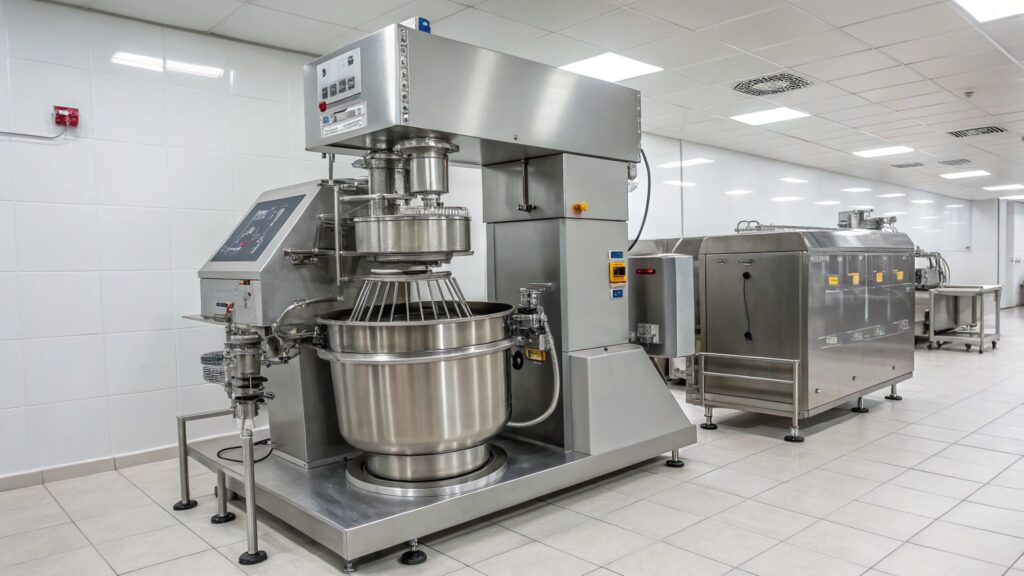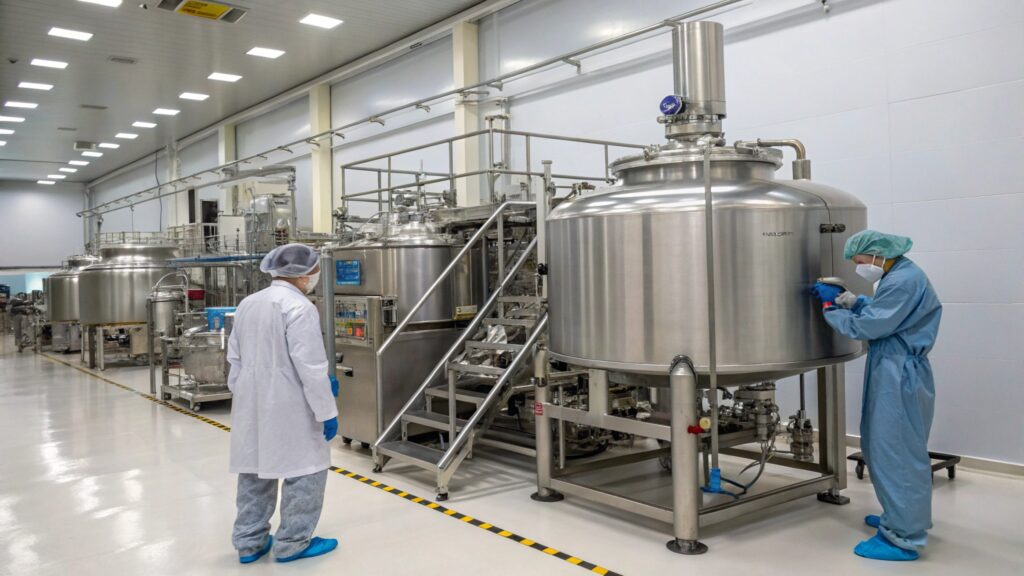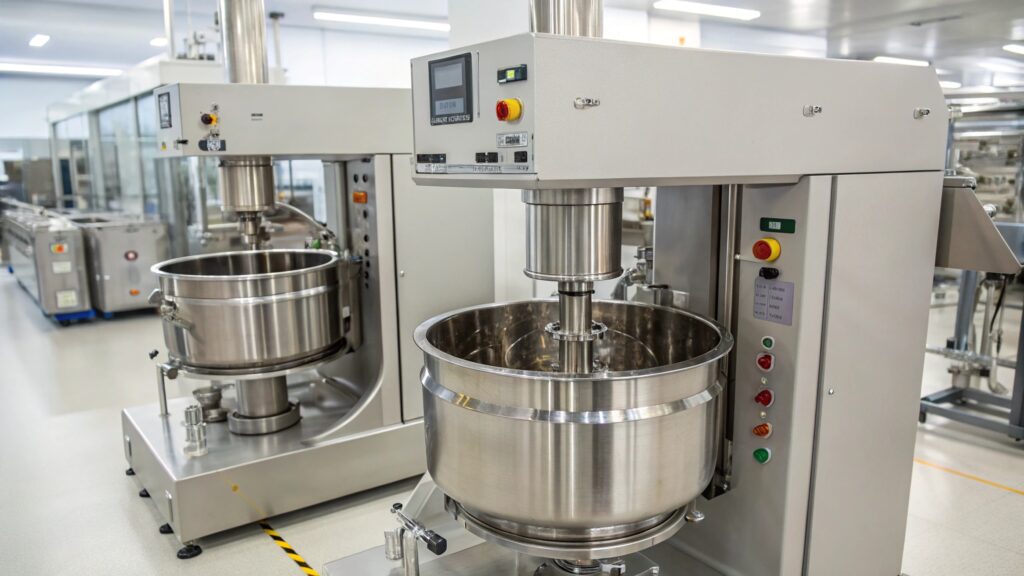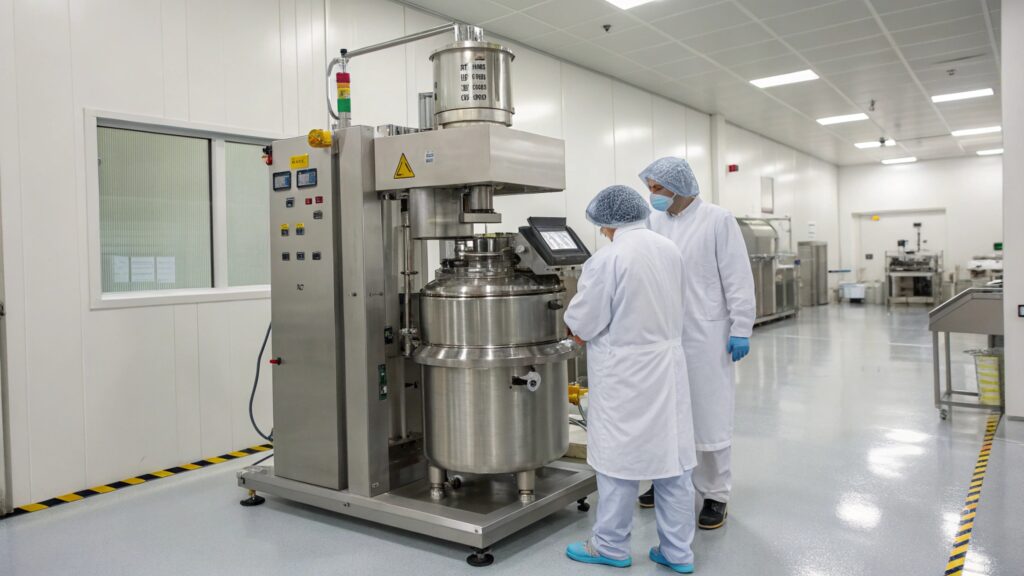High-viscosity pharmaceutical formulations challenge conventional mixing equipment, leading to inconsistent batches, extended processing times, and regulatory compliance failures.
Double planetary mixers excel in high-viscosity pharmaceutical applications because their dual-motion design eliminates dead zones, provides gentle yet thorough mixing, and maintains product integrity while meeting stringent regulatory requirements.
Over my decade at MIXERSTAR, I’ve witnessed countless pharmaceutical manufacturers struggle with high-viscosity formulations. Traditional mixers simply cannot handle the unique challenges these materials present while maintaining the quality and consistency that pharmaceutical applications demand.
What Makes High-Viscosity Pharmaceutical Formulations So Challenging to Mix?
High-viscosity pharmaceutical materials present unique mixing challenges that standard equipment cannot overcome effectively or consistently.
High-viscosity pharmaceutical formulations resist flow, create mixing dead zones, trap air bubbles, and require extended processing times that can degrade sensitive active ingredients.
Last month, I worked with a topical medication manufacturer struggling with their zinc oxide ointment1 production. Their existing paddle mixer couldn’t penetrate the 85% solid content formulation, creating lumps and inconsistent drug distribution. This problem is more common than most people realize.
High-viscosity materials resist conventional mixing forces because their thick consistency prevents proper circulation patterns. Standard paddle mixers create stagnant zones where material remains unmixed, even after extended processing times. These dead zones lead to batch inconsistencies that can affect drug efficacy and patient safety.
The thick consistency also traps air bubbles that become extremely difficult to remove. These bubbles can cause product instability, affect appearance, and create dosing inconsistencies. Traditional mixers often introduce more air during processing, making the problem worse rather than better.
| Viscosity Challenge | Impact on Product | Manufacturing Consequence |
|---|---|---|
| Dead zone formation | Uneven drug distribution | Batch failures, rework |
| Air bubble entrapment | Product instability | Shelf life reduction |
| Extended mixing times | API degradation | Potency loss |
| Inadequate shear | Poor homogeneity | Regulatory issues |
Temperature control becomes critical with high-viscosity materials2. Many pharmaceutical formulations require specific temperature ranges to maintain API stability. However, extended mixing generates heat that can push temperatures beyond acceptable limits. This thermal stress can degrade active ingredients and affect product performance.
Shear sensitivity adds another layer of complexity. Many pharmaceutical ingredients break down under excessive mechanical stress. Finding the right balance between sufficient mixing energy and gentle processing requires precise control that standard mixers cannot provide.
Our medium-scale planetary mixers address these challenges through their unique design that provides thorough mixing without the excessive shear that damages sensitive compounds.
How Do Double Planetary Mixers Overcome High-Viscosity Mixing Challenges?
Double planetary mixers solve high-viscosity mixing problems through their unique dual-motion design that eliminates dead zones and provides controlled mixing action.
The dual-motion design creates multiple mixing zones that continuously move material from vessel walls to the center, ensuring complete mixing without excessive shear or extended processing times.
I remember demonstrating our technology to a pharmaceutical company that had been struggling with paste-like formulations for months. Within minutes of seeing the double planetary action3, they understood why their existing equipment was failing them consistently.
The planetary motion pattern ensures that both mixing blades contact every point in the vessel within just 36 revolutions. This systematic coverage eliminates the dead zones that plague conventional mixers. Material continuously moves from the vessel walls toward the center, where it encounters the mixing blades repeatedly.
The blade design specifically addresses high-viscosity challenges4. Our HV (High Viscosity) blades feature helical contours that create both axial and radial flow patterns. This design pushes material downward while preventing it from climbing up the shaft, maintaining proper mixing action throughout the process.
| Design Feature | Viscosity Benefit | Pharmaceutical Advantage |
|---|---|---|
| Dual rotation | Complete zone coverage | Uniform drug distribution |
| Helical blades | Efficient material turnover | Reduced processing time |
| Vertical orientation | No shaft seals in product | Contamination prevention |
| Variable speed | Optimized mixing energy | Gentle processing |
The vacuum capability5 removes trapped air bubbles that cause problems in high-viscosity formulations. Vacuum levels down to 0.1 mbar effectively degas even the thickest materials. This capability proves essential for ointments, creams, and paste-like formulations where air bubbles affect product quality.
Temperature control through jacketed vessels maintains optimal processing conditions. The large heat transfer surface area of the vessel walls provides efficient heating or cooling. This control prevents thermal degradation while maintaining the viscosity levels needed for proper mixing.
The gentle mixing action prevents shear degradation of sensitive APIs. Unlike high-shear mixers that can break molecular bonds, double planetary mixers provide thorough blending through controlled mechanical action. This approach maintains ingredient integrity while achieving the homogeneity required for pharmaceutical applications.
Why Are Double Planetary Mixers Ideal for Pharmaceutical Regulatory Compliance?
Double planetary mixers incorporate design features that support pharmaceutical regulatory compliance while maintaining mixing performance and product quality.
The sanitary design, documentation packages, validation support, and cleaning capabilities of double planetary mixers meet FDA cGMP requirements and other international pharmaceutical regulations.
During a recent FDA inspection at one of our client facilities, the inspector specifically praised the mixer’s design documentation and cleaning validation protocols. This preparation made the difference between a smooth audit and potential regulatory issues.
The sanitary design6 eliminates product contact with seals, bearings, and other potential contamination sources. The vertical orientation keeps all rotating components above the product zone. This design prevents lubricants or wear particles from contaminating the pharmaceutical product, which is crucial for maintaining product purity.
Surface finishes meet pharmaceutical standards with electropolished stainless steel7 that achieves Ra values below 0.5 microns. These smooth surfaces prevent particle adhesion and bacterial growth while supporting effective cleaning. The finish quality directly impacts cleaning validation and regulatory acceptance.
| Compliance Feature | Regulatory Benefit | Implementation |
|---|---|---|
| Sanitary design | Contamination prevention | No product contact seals |
| Smooth surfaces | Easy cleaning validation | Electropolished finish |
| Documentation | Audit support | Complete design records |
| CIP capability | Validated cleaning | Automated systems |
Clean-in-place (CIP) systems8 ensure consistent cleaning between batches. The spray ball placement and flow patterns clean all internal surfaces effectively. This automation reduces operator variability and provides the documentation needed for cleaning validation studies.
Material traceability documentation supports equipment qualification and process validation activities. We provide complete material certificates, dimensional inspections, and surface finish measurements. This documentation package accelerates validation timelines and supports regulatory submissions.
The changeable bowl design enables dedicated vessels for different products. This approach minimizes cross-contamination risks while reducing cleaning validation requirements. Many pharmaceutical manufacturers maintain separate bowls for different drug products to prevent any possibility of cross-contamination.
Our custom mixing solutions can incorporate additional compliance features such as data logging systems, electronic batch records, and 21 CFR Part 11 compliance for companies with specific regulatory requirements.
What Specific Pharmaceutical Applications Benefit Most from Double Planetary Mixing?
Certain pharmaceutical applications particularly benefit from double planetary mixing technology due to their unique formulation challenges and quality requirements.
Topical medications, vaccine adjuvants, controlled-release formulations, and high-concentration APIs benefit most from double planetary mixing due to their high-viscosity requirements and sensitivity to processing conditions.
A recent project involved mixing adjuvants for a major vaccine manufacturer. Their existing equipment couldn’t achieve the uniform distribution needed for consistent immune response. Our double planetary mixer solved this challenge by providing the gentle yet thorough mixing required for these sensitive formulations.
Topical medications represent one of the most demanding applications for double planetary mixers. Ointments, creams, and gels require uniform drug distribution while maintaining specific texture and rheological properties. The high solid content typical of these formulations challenges conventional mixing equipment.
The dual-motion design ensures that active ingredients distribute evenly throughout the base formulation. This uniformity proves critical for topical medications where inconsistent drug distribution can affect therapeutic efficacy. Patients depend on consistent dosing from each application.
| Application Type | Mixing Challenge | Double Planetary Solution |
|---|---|---|
| Topical ointments | High solid content | Efficient turnover action |
| Vaccine adjuvants | Gentle processing | Controlled shear mixing |
| Controlled-release | Uniform coating | Complete zone coverage |
| High-concentration APIs | Viscous solutions | Powerful mixing action |
Vaccine adjuvants require extremely gentle processing to preserve the immunological properties of the active components. Excessive shear can damage protein structures and reduce vaccine effectiveness. The controlled mixing action of double planetary mixers provides thorough blending without the aggressive forces that damage sensitive biologics.
Controlled-release formulations benefit from the uniform mixing that ensures consistent drug release profiles. These formulations often involve coating drug particles with polymer matrices that control release rates. Uniform coating thickness requires thorough mixing that reaches every particle surface.
High-concentration API formulations challenge mixing equipment due to their extreme viscosity. These formulations require powerful mixing action to achieve homogeneity while maintaining gentle processing to prevent API degradation. The dual-motion design provides the energy needed for effective mixing without excessive shear.
Our large industrial mixers handle high-volume pharmaceutical production while maintaining the mixing quality that smaller units provide. This scalability allows companies to maintain consistent product quality from clinical trial materials through commercial production.
Conclusion
Double planetary mixers excel in high-viscosity pharmaceutical applications through their unique design, regulatory compliance features, and superior mixing performance for challenging formulations.
External link
-
Explore this link to discover effective methods and tips for optimizing zinc oxide ointment production. ↩
-
Learn more about the challenges and solutions for mixing high-viscosity materials in pharmaceutical applications. ↩
-
Explore how double planetary action revolutionizes mixing processes, ensuring efficient and uniform results for high-viscosity formulations. ↩
-
Learn about the unique challenges posed by high-viscosity materials and how specialized equipment can overcome these issues. ↩
-
Discover the importance of vacuum capability in removing air bubbles and enhancing the quality of high-viscosity products. ↩
-
Explore how sanitary design enhances product safety and compliance in pharmaceutical manufacturing. ↩
-
Learn about the advantages of electropolished stainless steel for maintaining product purity and regulatory standards. ↩
-
Discover how CIP systems streamline cleaning processes and ensure compliance in pharmaceutical production. ↩





![![]() Pharmaceutical applications double planetary mixer](https://mixerstar.com/wp-content/uploads/2025/07/pharmaceutical-applications-double-planetary-mixer-1024x576.jpg)



